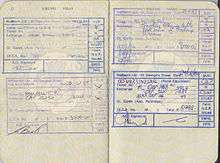Foreign exchange controls
| Foreign exchange |
|---|
| Exchange rates |
| Markets |
| Assets |
| Historical agreements |
| See also |

Foreign exchange controls are various forms of controls imposed by a government on the purchase/sale of foreign currencies by residents or on the purchase/sale of local currency by nonresidents.
Common foreign exchange controls include:
- Banning the use of foreign currency within the country
- Banning locals from possessing foreign currency
- Restricting currency exchange to government-approved exchangers
- Fixed exchange rates
- Restrictions on the amount of currency that may be imported or exported
Countries with foreign exchange controls are also known as "Article 14 countries," after the provision in the International Monetary Fund agreement allowing exchange controls for transitional economies. Such controls used to be common in most countries, particularly poorer ones, until the 1990s when free trade and globalization started a trend towards economic liberalization. Today, countries which still impose exchange controls are the exception rather than the rule.
Often, foreign exchange controls can result in the creation of black markets to exchange the weaker currency for stronger currencies. This leads to a situation where the exchange rate for the foreign currency is much higher than the rate set by the government, and therefore creates a shadow currency exchange market. As such, it is unclear whether governments have the ability to enact effective exchange controls.[1]
Current countries with foreign exchange controls
Note that this list is very incomplete.
See also
- Currency transaction tax
- Financial transaction tax
- Spahn tax
- Sterling Area
- Tobin tax
- Foreign Exchange Dealers Coalition
Notes
References
- ↑ "The Use of Foreign Exchange Controls to Promote Economical Stability". earnforex.com. Retrieved 8 July 2013.
- ↑ "The Central Bank of The Bahamas". Centralbankbahamas.com. Retrieved 2013-06-14.
- ↑ "Foreign Investment Laws and Regulations in Nepal". 27 September 2012. Retrieved 5 May 2015.
- ↑ Annual Report on Exchange Arrangements and Exchange Restrictions 1979 - International Monetary Fund - Google Books. Books.google.com. 2000-02-29. ISBN 9781557758989. Retrieved 2013-06-14.